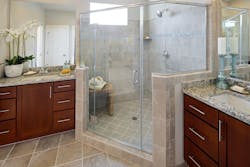A Builder's Advice on Marketing Homes in 2016
It’s an exciting time to be a homebuilder: With the recession in our rear-view mirror, we’re seeing a renewed commitment to customized homes and an increase in homeowner investment. Looking forward to 2016, our forecast includes industry-shifting technology, new types of living spaces, and even a change in design aesthetic and appeal.
Programmable Homes
One of the most exciting trends in home development involves what experts call “The Internet of Things,” otherwise known as smart devices that connect to one another digitally. Gartner.com estimates that the Internet of Things industry revenue will exceed $300 billion by 2020, and total smart devices will amount to 26 billion worldwide. Smart thermostats that allow users to control temperature in their homes from their phones, smart outlets that can be turned on and off remotely, apps to control lighting, and even sensors which inform homeowners when a pipe has burst in their homes: The future of home design and development heavily involves the digital sphere. Still unsure? Consider the huge number of big-name acquisitions that have taken place over the last couple years: Samsung purchasing SmartThings, Google acquiring Nest, plus Dropcam and Revolv and Apple’s announcement of HomeKit.
As the tech industry expands, more homes are coming equipped with devices that automate, regulate and truly expand the boundaries of modern systems, leading developers to push resources in equipping homes and staying up to date with innovation.
Rise of the Silver Tide
With the majority of Baby Boomers winding down careers and looking for their next dream home, there’s a growing market for homes that are geared toward this demographic. But Baby Boomers aren’t ditching their single-family detached homes too quickly. With an ample retirement fund saved, those who can afford it are carefully considering future options, and want to make the right choice for the right price. Accustomed to a certain quality of life, these homeowners will require all the perks, amenities and style of their current homes, but with specific built-in conveniences such as first floor master suites and easy maintenance yards that can best be achieved in a new home.
For some Boomers, living with family will be their next abode. This theory is supported by the growing trend that more than half of homebuyers aged 55 and older report that they’d prefer a home with an in-law suite, which is up from 28% in 2007. This brings us to our next trend…
Multigenerational Living Coming To Stay
As of 2012, more than 18% of adults are living in multi-generational households, comprising grandparents down to young children. This means approximately 57 million Americans — double the amount that lived in multigenerational homes in 1980 — are sharing homes with larger familial units. Whether this is by financial necessity or cultural preference, it’s clear that home developers should keep this growing demographic in mind when designing. Basement bedrooms with en suite bathrooms, multilevel living and strategic use of space will all factor in heavily for this demographic.
In-Home Getaway Space
In 2016, relaxing on the living room couch won’t be enough: We’re seeing a serious growth in peaceful getaway spaces — or “retreat rooms” — that take the shape of a spa, meditation or yoga room. Complete with sound systems and hardwood floors, these spaces are designed for truly escaping distractions, devices and even other family members.
Flex Space
“Open floorplans” ring a bell? There’s little tolerance in the marketplace for the closed-off rooms of the past. The next evolution of open floorplans, flex space, is marked by a blending together of functionality and entertainment: The kitchen is adjacent and open to the great room, dining rooms double as a study, and mud rooms are perfect as craft rooms.
Urban Edge Comes to the Suburbs
In terms of architectural aesthetic, the industrial spirit of urban space is making its way to the suburbs, as more recent college graduates transition to tech jobs in second-tier cities. Contemporary styling, exposed brick and industrial fixtures are must-haves for former urban dwellers.
Outdoor Living Areas
Outdoor living areas are no longer just for the warmer climates. Homeowners are increasingly looking to bridge indoor and outdoor living by infusing the convenience and comfort of indoors with the relaxing, spacious feel of outdoors. The result? An outdoor escape, perfectly equipped with all the amenities of indoor living. What was once a luxury has become standard and much more mainstream as homeowners want every inch of their homes to remain functional.
Wave Goodbye To…
· Soaking tubs. Gigantic soaking tubs were once the sign of ultimate luxury, but now every homebuyer is seduced by a gadget-filled spa showers with multiple shower heads, side jets, and electronic water controls that allow you to control water pressure and temperature.
· Kitchen desks. Once thought of as a convenience, desks in kitchens became more of a clutter headquarters than a helpful, office-like corner or a tech and charging center that’s tucked away in the family foyers (a.k.a., mud rooms) or upstairs loft.

